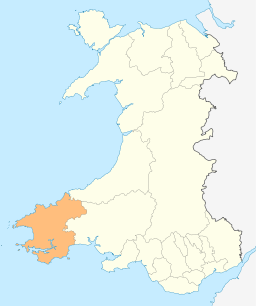Pembroke, Pembrokeshire
Pembroke
| |
|---|---|
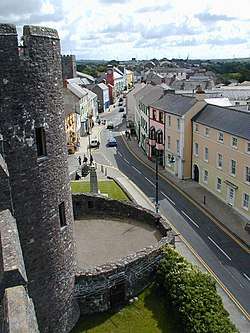 Main Street viewed from Pembroke Castle | |
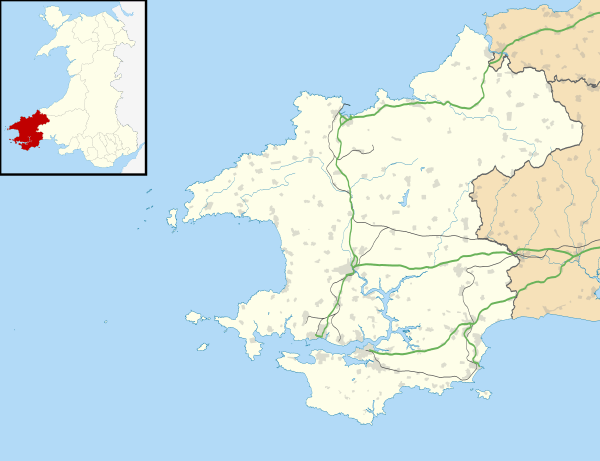 Pembroke Pembroke shown within Pembrokeshire | |
| Population | 7,552 (2011 census)[1] |
| OS grid reference | SM985015 |
| Community |
|
| Principal area | |
| Ceremonial county | |
| Country | Wales |
| Sovereign state | United Kingdom |
| Post town | PEMBROKE |
| Postcode district | SA71 |
| Dialling code | 01646 |
| Police | Dyfed-Powys |
| Fire | Mid and West Wales |
| Ambulance | Welsh |
| EU Parliament | Wales |
| UK Parliament | |
| Welsh Assembly | |
Pembroke (/ˈpɛmbrʊk/; Welsh: Penfro pronounced [pɛnˈvroː]) was the founding county town of Pembrokeshire in Wales. Pembroke still features a number of historic buildings, town walls and complexes. It is a community and one of the larger towns in the county with a population of 7,552.
Pembroke Castle was the birthplace of Henry Tudor, later to become Henry VII of England.
History
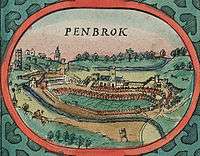
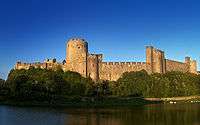
Pembroke Castle, the substantial remains of a stone medieval fortress founded by the Normans in 1093, stands at the Western tip of the peninsular surrounded by water on three sides. The castle was the seat of the powerful Earls of Pembroke and the birthplace of King Henry VII of England. Gerald de Windsor was the first recorded Constable of Pembroke. Pembroke town and castle and its surroundings are linked with the early Christian church. Following the final extension of the Castle about 1254 the town was extended and defensive perimeter walls erected around the edge of the town. The walls survive on their medieval foundations, although much rebuilt over the centuries. A great many of the town's original medieval burgage plots survive and are divided by early stone walls that are of significant national importance.
Monkton Priory, sited on a hill across the river from the castle, founded in 1098 by Arnulf de Montgomery and granted by him to the Benedictine order, has very early foundations and retains much of the Norman walls of the nave. The choir and sanctuary were renovated in the 19th Century. Monkton Hall, close by the Priory church, is regarded as the oldest domestic building in Pembrokeshire and possibly Wales and is thought to have been the guesthouse for visitors to the Priory.
The first stone building in the town was a defensive tower, now known as the Medieval Chapel, at 69a Main Street, built on a cliff edge between 950 AD and 1000 AD. There are the remains of a great hall to the north and recently filled-in arched cellars. The building was thought to have been later used as an early church as the layout is the same as St. Govan's Chapel and was used by John Wesley in 1764 to preach Methodism. In 1866 it became the brewery for the York Tavern which was briefly Oliver Cromwell's headquarters at the end of the Siege of Pembroke during the English Civil War.
The town's main bridge across the River Pembroke, which also acts as a dam, crosses and constrains the millpond. The first bridge was constructed to house a tide mill, originally granted to the Knight's Templar in 1199.[3] The last mill building was destroyed by fire in 1956.
On both banks of the Pembroke River to the west of the castle are many remains of early activities. The North Shore Quarries are relatively complete as are the remains of medieval and Elizabethan slipways where wooden vessels were built before the industrial dockyard and admiralty town was built on the grid pattern of Pembroke Dock. There is a very early complete graving dock in what was Hancock's Yard.
At Pennar Flats there was an early submarine base used for experiments in submarine warfare. Three of the houses on the then foreshore, part of the shipyard before the Admiralty Dock Yard was built, are still standing but are heavily altered.
The ferry port of Pembroke Dock is 3 miles (4.8 km) to the northwest of Pembroke. It was established in 1814.
Toponymy
The town and county derive their names from the cantref of Penfro: Pen = "head" or "end", and bro = "region", "country", "land", which has been interpreted to mean either "Land's End"[4] or "headland".[5]
Geography
Pembroke town stands on the South Pembrokeshire limestone peninsula by the estuary of the River Cleddau, flanked on all sides by woodland and arable farmland. The town is 8 miles (13 km) south of the county town of Haverfordwest.
The town is centred on Main Street, which is the only street that is inside the original Pembroke town walls. Outside the walls, residential estates have been built to the north towards Pembroke Dock, to the east towards Lamphey, and to the south. To the west of the town lies the village of Monkton, which is included as part of the community of Pembroke. At the 2001 census, the community had a population of 7,214.[6]
The conurbation of Pembroke Dock and Pembroke has a combined population of 15,890 and as such is one of the major population centres of West Wales.
Governance
The community of Pembroke covers an area of 4.58 square miles (1,190 ha)[7] and includes the Pembroke St Mary North, St Mary South, St Michael and Monkton wards.[7] The community has its own town council.[8] For 2013–14, the Mayor is Councillor K Nicholas and the Deputy Lord Mayor is Councillor A Carey.[9] The four wards comprising Pembroke community each elect one councillor to Pembrokeshire County Council.[10] Pembroke was part of the historic county of Pembrokeshire, abolished in 1974, which was reconstituted as a unitary authority when local government in Wales was reorganised in 1996. Between 1974 and 1996, Pembroke was part of the South Pembrokeshire district of Dyfed.
Pembroke is part of the Carmarthen West and South Pembrokeshire National Assembly for Wales constituency and UK Parliamentary constituency. The local Assembly Member is Angela Burns of the Conservative Party[11] and the local Member of Parliament is Simon Hart, also a Conservative.[12]
Education
Primary and pre-school (ages 3–11) education in Pembroke is served by two state schools. In Pembroke town, Golden Grove CP School is a dual stream school established in 2002 following the amalgamation of Golden Manor Infants School and Grove Junior School.[13] In Monkton, pupils can attend Monkton Priory CP School.
Secondary education is provided by Pembroke School (in Welsh: Ysgol Benfro), a mixed 11–18 comprehensive school of 1,600 pupils with a sixth form of about 200. The school was formed in 1972 as a result of the amalgamation of the former grammar school and secondary modern school. The school takes pupils from the Pembroke family of schools, which as well as Golden Grove and Monkton Priory includes community primary schools in Lamphey, Orielton, Pennar and Pembroke Dock, voluntary controlled primary schools in Angle, Cosheston and Stackpole, and St. Mary's Catholic Primary School in Pembroke Dock.[14]
Broadband blackspot
In February 2012, it was revealed that Pembroke is the UK's second-slowest broadband town.[15] The average internet download speed in Pembroke was just over 1.6 Mbit/s (1600 kbit/s) compared to the UK average of 12.0 Mbit/s (12000 kbit/s) at the time.
BT's telephone exchange, which serves Pembroke and Pembroke Dock, was upgraded in 2014 under the Superfast Cymru programme and new cabinets were built to provide FTTC technology. Additional exchanges across Pembrokeshire are also being upgraded under the programme, with a goal of bringing superfast broadband to 96% of Wales by spring 2016.[16]
Culture and community
Pembroke 21C community association was founded in 2004, and is based out of the Foundry House building on the Commons, which they operate as a community centre. Activities carried out by 21C include organising the annual Pembroke Festival, running the town's fortnightly farmers' market and producing a quarterly newsletter which is distributed to all households in the town. Pembroke Rugby Club organises the town's annual carnival, which is usually held in June. Pembroke Library shares a building with the Tourist Information Centre on Commons Road and offers a full lending service and internet access.
Pembroke is twinned with the towns of Bergen, Lower Saxony, Germany since 1977[17] and Pembroke, Malta since 2002.
Notable people
- See Category:People from Pembroke, Pembrokeshire
Besides King Henry VII, notable natives of Pembroke include the composer Daniel Jones, actor Mervyn Johns and John Lawrence from the popular music band Gorky's Zygotic Mynci. [18]
Sport
Pembroke Rugby Club is on Upper Lamphey Road. The ground is called Crickmarren. The club plays in WRU Division Five West. Pembroke's main game of the season is often the local derby with rivals the Pembroke Dock Harlequins. Pembroke produced Ospreys and Welsh international Jonathan Thomas.
Other sporting clubs in the area include the football team Monkton Swifts.
The town is home to Pembroke Cricket Club. The cricket club plays its home games at its Treleet ground on Upper Lamphey Road, opposite the rugby club. The club currently has a 1st and a 2nd team playing in divisions 2 and 4 of the Pembrokeshire league. The club colours are green and gold.
Pembroke Welsh Corgi
Transport
Road
Main Street, the A4139, runs through the town centre in a one-way system due to the narrowness of the road. The A4075 is accessed from the east end of Main Street and connects Pembroke to the A477.
Rail
Pembroke railway station is on a branch of West Wales Lines. There is a two-hourly regular service between Swansea and Pembroke Dock via Tenby.
Air
The nearest passenger airport is Cardiff International Airport which is about 93 miles (150 km) away.
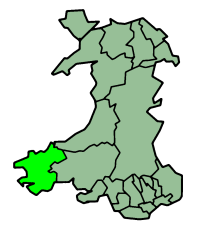
Pembroke shown within Pembrokeshire UA
References
- ↑ "4 Wards and community population 2011". Retrieved 20 April 2015.
- ↑ http://www.pembroketownguide.org.uk/
- ↑ "Pembroke Town Guide". Retrieved 24 June 2009.
- ↑ Charles, B. G., The Placenames of Pembrokeshire, National Library of Wales, Aberystwyth, 1992, ISBN 0-907158-58-7, p 671
- ↑ Lewis, Samuel (1833). A Topographical Dictionary of Wales. 2. p. 2N.
- ↑ Census data
- 1 2 Settlement Populations, Pembrokeshire County Council 2001 Census Retrieved 17 January 2010
- ↑ "Pembroke Town Council". Pembrokeshire County Council. Retrieved 1 March 2014.
- ↑ "Pembroke Town Guide – The Mayor". Pembroke Town Council. Retrieved 1 March 2014.
- ↑ "Pembrokeshire County Council – Find your councillor". Pembrokeshire County Council. Retrieved 1 March 2014.
- ↑ Carmarthen West and South Pembrokeshire BBC Election – Carmarthen West and Pembrokeshire South
- ↑ Carmarthen West and South Pembrokeshire BBC Election – Carmarthen West and Pembrokeshire South
- ↑ Harries, Jeffrey (13 April 2005). "Inspection Report Golden Grove Community Primary School". Estyn: 1.
- ↑ "Pembrokeshire Schools". Pembrokeshire County Council. 15 January 2014.
- ↑ "'Third of UK postcodes' have slow broadband speeds". BBC News. 23 February 2012.
- ↑ "Welsh Government: Superfast broadband rolling-out across Pembrokeshire". Archived from the original on 29 November 2014. Retrieved 23 March 2015.
- ↑ "Twin town visit to Bergen for Pembroke students". pembroke-today.co.uk. Tindle Newspapers Limited. 21 June 2013.
- ↑ Asbridge, Thomas. The Greatest Knight: The Remarkable Life of William Marshall. Harper Collins Publishers. p. total 481 pages.
External links
| Wikimedia Commons has media related to Pembroke Castle. |

